Toughening Thermoelectric Materials: From Mechanisms to Applications
Abstract
1. Introduction
2. Intrinsically Ductile Thermoelectric Materials
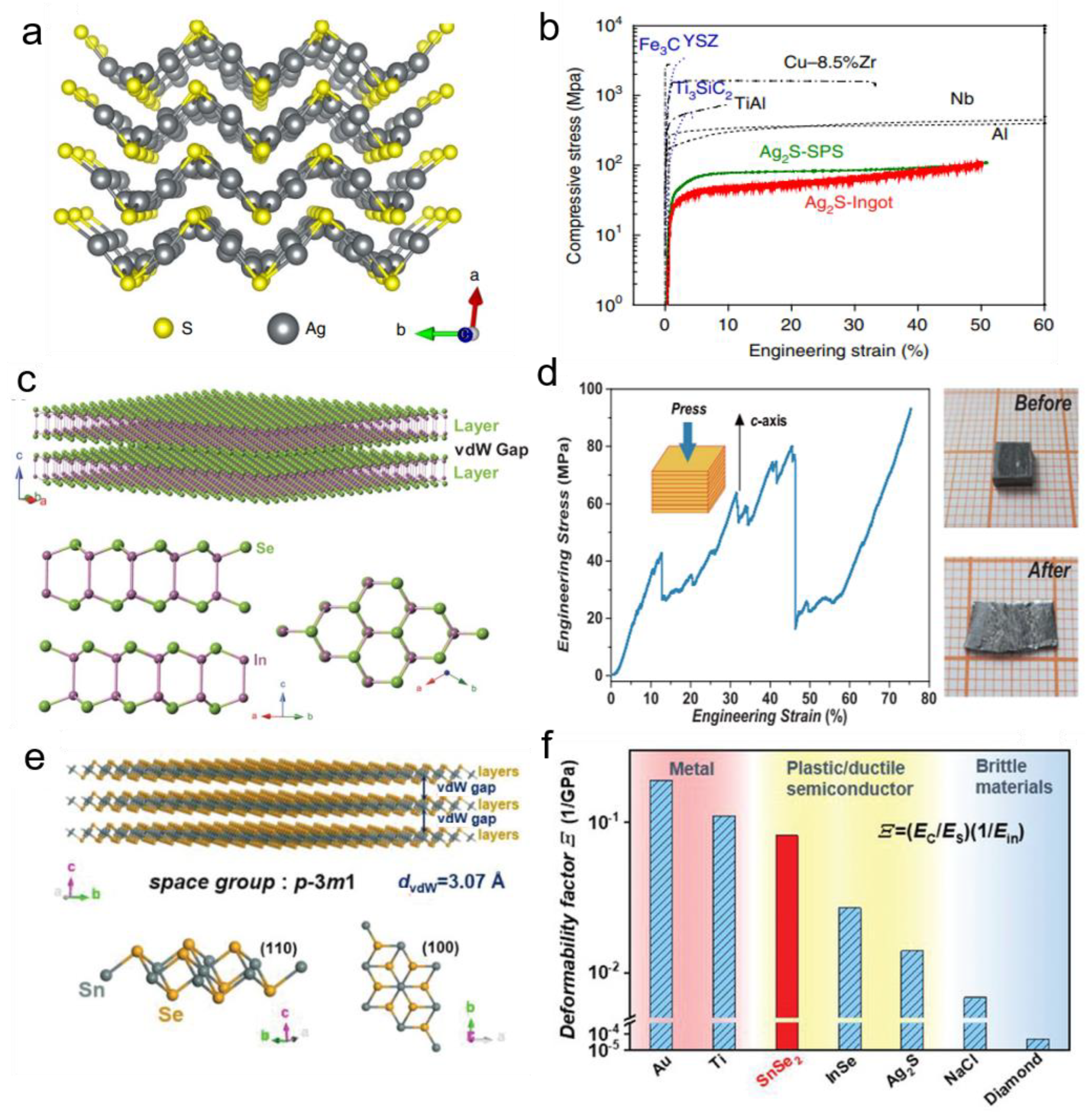
3. Toughening Strategies of Thermoelectric Materials
3.1. Size Effect
3.2. Twin Boundary Engineering
3.3. High-Entropy Engineering
3.4. Other Toughening Strategies
4. Flexible Thermoelectric Devices

5. Conclusions
- (1)
- The intrinsic ductility of thermoelectric materials like α–Ag2S, β–InSe, and SnSe2 can be achieved by optimal configurations of chemical bonds and crystal structures. The deformability factor criterion is expected to develop more intrinsically ductile thermoelectric materials.
- (2)
- To further improve the mechanical properties of thermoelectric materials, we summarized promising toughness strategies, including the size effect, twin boundary engineering, and high-entropy engineering. We also briefly concluded some other toughening strategies, i.e., nano-precipitates, dislocation engineering, and temperature effect.
- (3)
- With the recent advances in ductile thermoelectric materials with high thermoelectric performance, flexible thermoelectric devices have been designed and fabricated with different dimensions to cater to various application scenarios, including generators, health monitors, teleoperation, and soft robotics.
Author Contributions
Funding
Institutional Review Board Statement
Informed Consent Statement
Data Availability Statement
Acknowledgments
Conflicts of Interest
References
- Snyder, G.J.; Toberer, E.S. Complex thermoelectric materials. Nat. Mater. 2008, 7, 105–114. [Google Scholar] [CrossRef]
- Yang, J.H.; Caillat, T. Thermoelectric materials for space and automotive power generation. Mrs Bull. 2006, 31, 224–229. [Google Scholar] [CrossRef]
- Wang, Y.; Tang, Z.Y.; Tan, S.S.; Kotov, N.A. Biological assembly of nanocircuit prototypes from protein-modified CdTe nanowires. Nano Lett. 2005, 5, 243–248. [Google Scholar] [CrossRef] [PubMed]
- Fukutani, K.; Shakouri, A. Design of bulk thermoelectric modules for integrated circuit thermal management. Ieee Trans. Compon. Packag. Technol. 2006, 29, 750–757. [Google Scholar] [CrossRef]
- Vora-ud, A.; Thanachayanont, C.; Jugsujinda, S.; Amornkitbamrung, V.; Seetawana, T. Study on Electronic Structure of β-In2Te3 Thermoelectric Materialfor Alternative Energy. Procedia Eng. 2011, 8, 2–7. [Google Scholar] [CrossRef]
- Xin, J.; Basit, A.; Li, S.; Danto, S.; Tjin, S.C.; Wei, L. Inorganic thermoelectric fibers: A review of materials, fabrication methods, and applications. Sensors 2021, 21, 3437. [Google Scholar] [CrossRef]
- Slack, G.A.R.; Michael, D. CRC Handbook of Thermoelectrics; CRC Press: Boca Raton, FL, USA, 1995. [Google Scholar]
- He, J.; Tritt, T.M. Advances in thermoelectric materials research: Looking back and moving forward. Science 2017, 357, eaak9997. [Google Scholar] [CrossRef]
- Chasmar, R.P.; Stratton, R. The Thermoelectric Figure of Merit and its Relation to Thermoelectric Generators†. J. Electron. Control 1959, 7, 52–72. [Google Scholar] [CrossRef]
- Tang, X.F.; Xie, W.J.; Li, H.; Zhao, W.Y.; Zhang, Q.J.; Niino, M. Preparation and thermoelectric transport properties of high-performance p-type Bi2Te3 with layered nanostructure. Appl. Phys. Lett. 2007, 90, 012102. [Google Scholar] [CrossRef]
- Duan, B.; Yang, J.; Salvador, J.R.; He, Y.; Zhao, B.; Wang, S.Y.; Wei, P.; Ohuchi, F.S.; Zhang, W.Q.; Hermann, R.P.; et al. Electronegative guests in CoSb3. Energy Environ. Sci. 2016, 9, 2090–2098. [Google Scholar] [CrossRef]
- Shi, X.; Yang, J.; Salvador, J.R.; Chi, M.F.; Cho, J.Y.; Wang, H.; Bai, S.Q.; Yang, J.H.; Zhang, W.Q.; Chen, L.D. Multiple-Filled Skutterudites: High Thermoelectric Figure of Merit through Separately Optimizing Electrical and Thermal Transports. J. Am. Chem. Soc. 2011, 133, 7837–7846. [Google Scholar] [CrossRef] [PubMed]
- Zhu, T.J.; Fu, C.G.; Xie, H.H.; Liu, Y.T.; Zhao, X.B. High Efficiency Half-Heusler Thermoelectric Materials for Energy Harvesting. Adv. Energy Mater. 2015, 5, 1500588. [Google Scholar] [CrossRef]
- Liu, H.L.; Shi, X.; Xu, F.F.; Zhang, L.L.; Zhang, W.Q.; Chen, L.D.; Li, Q.; Uher, C.; Day, T.; Snyder, G.J. Copper ion liquid-like thermoelectrics. Nat. Mater. 2012, 11, 422–425. [Google Scholar] [CrossRef]
- He, Y.; Day, T.; Zhang, T.S.; Liu, H.L.; Shi, X.; Chen, L.D.; Snyder, G.J. High Thermoelectric Performance in Non-Toxic Earth-Abundant Copper Sulfide. Adv. Mater. 2014, 26, 3974–3978. [Google Scholar] [CrossRef]
- Han, C.; Sun, Q.; Li, Z.; Dou, S.X. Thermoelectric Enhancement of Different Kinds of Metal Chalcogenides. Adv. Energy Mater. 2016, 6, 1600498. [Google Scholar] [CrossRef]
- Shi, X.; Chen, H.Y.; Hao, F.; Liu, R.H.; Wang, T.; Qiu, P.F.; Burkhardt, U.; Grin, Y.; Chen, L.D. Room-temperature ductile inorganic semiconductor. Nat. Mater. 2018, 17, 421–426. [Google Scholar] [CrossRef] [PubMed]
- Pei, Y.Z.; Shi, X.Y.; LaLonde, A.; Wang, H.; Chen, L.D.; Snyder, G.J. Convergence of electronic bands for high performance bulk thermoelectrics. Nature 2011, 473, 66–69. [Google Scholar] [CrossRef]
- Zhang, Q.Y.; Wang, H.Z.; Zhang, Q.A.; Liu, W.S.; Yu, B.; Wang, H.; Wang, D.Z.; Ni, G.; Chen, G.; Ren, Z.F. Effect of Silicon and Sodium on Thermoelectric Properties of Thallium-Doped Lead Telluride-Based Materials. Nano Lett. 2012, 12, 2324–2330. [Google Scholar] [CrossRef]
- Zhu, T.; Bai, H.; Zhang, J.; Tan, G.J.; Yan, Y.G.; Liu, W.; Su, X.L.; Wu, J.S.; Zhang, Q.J.; Tang, X.F. Realizing High Thermoelectric Performance in Sb-Doped Ag2Te Compounds with a Low-Temperature Monoclinic Structure. Acs Appl. Mater. Interfaces 2020, 12, 39425–39433. [Google Scholar] [CrossRef]
- Zhao, K.P.; Guan, M.J.; Qiu, P.F.; Blichfeld, A.B.; Eikeland, E.; Zhu, C.X.; Ren, D.D.; Xu, F.F.; Iversen, B.B.; Shi, X.; et al. Thermoelectric properties of Cu2Se1-xTex solid solutions. J. Mater. Chem. A 2018, 6, 6977–6986. [Google Scholar] [CrossRef]
- Chen, J.; Yuan, H.; Zhu, Y.K.; Zheng, K.; Ge, Z.H.; Tang, J.; Zhou, D.; Yang, L.; Chen, Z.G. Ternary Ag2Se1-xTex: A Near-Room-Temperature Thermoelectric Material with a Potentially High Figure of Merit. Inorg. Chem. 2021, 60, 14165–14173. [Google Scholar] [CrossRef]
- Zhang, F.J.; He, S.; Li, R.H.; Lin, L.W.; Ren, D.; Liu, B.; Ang, R. Advancing thermoelectrics by vacancy engineering and band manipulation in Sb-doped SnTe-CdTe alloys. Appl. Phys. Lett. 2021, 119, 172101. [Google Scholar] [CrossRef]
- Li, G.; He, J.; An, Q.; Morozov, S.I.; Hao, S.; Zhai, P.; Zhang, Q.; Goddard, W.A.; Snyder, G.J. Dramatically reduced lattice thermal conductivity of Mg2Si thermoelectric material from nanotwinning. Acta Mater. 2019, 169, 9–14. [Google Scholar] [CrossRef]
- Li, J.; Zhang, X.; Ma, H.; Duan, B.; Li, G.; Yang, J.; Wang, H.; Yang, H.; Zhou, L.; Zhai, P. Dual occupations of sulfur induced band flattening and chemical bond softening in p-type S Co4Sb12-2S2 skutterudites. J. Mater. 2022, 8, 88–95. [Google Scholar] [CrossRef]
- Li, J.; Duan, B.; Yang, H.; Wang, H.; Li, G.; Yang, J.; Chen, G.; Zhai, P. Thermoelectric properties of electronegatively filled SyCo4−xNixSb12 skutterudites. J. Mater. Chem. C 2019, 7, 8079–8085. [Google Scholar] [CrossRef]
- Wang, H.; Ma, H.; Duan, B.; Geng, H.; Zhou, L.; Li, J.; Zhang, X.; Yang, H.; Li, G.; Zhai, P. High-Pressure Rapid Preparation of High-Performance Binary Silver Sulfide Thermoelectric Materials. ACS Appl. Energy Mater. 2021, 4, 1610–1618. [Google Scholar] [CrossRef]
- Faber, K.T.; Malloy, K.J. The Mechanical Properties of Semiconductors; Academic Press: Cambridge, MA, USA, 1992; Volume 37. [Google Scholar]
- Tyagi, K.; Gahtori, B.; Bathula, S.; Jayasimhadri, M.; Sharma, S.; Singh, N.K.; Haranath, D.; Srivastava, A.K.; Dhar, A. Crystal structure and mechanical properties of spark plasma sintered Cu2Se: An efficient photovoltaic and thermoelectric material. Solid State Commun. 2015, 207, 21–25. [Google Scholar] [CrossRef]
- Greenaway, D.L.; Harbeke, G. Band structure of bismuth telluride, bismuth selenide and their respective alloys. J. Phys. Chem. Solids 1965, 26, 1585–1604. [Google Scholar] [CrossRef]
- Qiu, J.; Yan, Y.; Luo, T.; Tang, K.; Yao, L.; Zhang, J.; Zhang, M.; Su, X.; Tan, G.; Xie, H.; et al. 3D Printing of highly textured bulk thermoelectric materials: Mechanically robust BiSbTe alloys with superior performance. Energy Environ. Sci. 2019, 12, 3106–3117. [Google Scholar] [CrossRef]
- Bao, D.; Chen, J.; Yu, Y.; Liu, W.; Huang, L.; Han, G.; Tang, J.; Zhou, D.; Yang, L.; Chen, Z.-G. Texture-dependent thermoelectric properties of nano-structured Bi2Te3. Chem. Eng. J. 2020, 388, 124295. [Google Scholar] [CrossRef]
- Zhang, L.; Wang, W.; Ren, B.; Yan, Y. Thermoelectric Performance and High-Temperature Creep Behavior of GeTe-Based Thermoelectric Materials. J. Electron. Mater. 2011, 40, 1057–1061. [Google Scholar] [CrossRef]
- Shi, X.L.; Liu, W.D.; Wu, A.Y.; Nguyen, V.T.; Gao, H.; Sun, Q.; Moshwan, R.; Zou, J.; Chen, Z.G. Optimization of sodium hydroxide for securing high thermoelectric performance in polycrystalline Sn1-xSe via anisotropy and vacancy synergy. InfoMat 2019, 2, 1201–1215. [Google Scholar] [CrossRef]
- Zhao, L.-D.; Chang, C.; Tan, G.; Kanatzidis, M.G. SnSe: A remarkable new thermoelectric material. Energy Environ. Sci. 2016, 9, 3044–3060. [Google Scholar] [CrossRef]
- Itakura, M.; Kaburaki, H.; Yamaguchi, M.; Tsuru, T. Atomistic study on the cross-slip process of a screw <a> dislocation in magnesium. Model. Simul. Mater. Sci. Eng. 2015, 23, 065002. [Google Scholar] [CrossRef]
- Li, G.; An, Q.; Morozov, S.I.; Duan, B.; Goddard, W.A.; Zhang, Q.; Zhai, P.; Snyder, G.J. Ductile deformation mechanism in semiconductor α-Ag2S. NPJ Comput. Mater. 2018, 4, 44. [Google Scholar] [CrossRef]
- Wei, T.R.; Jin, M.; Wang, Y.C.; Chen, H.Y.; Gao, Z.Q.; Zhao, K.P.; Qiu, P.F.; Shan, Z.W.; Jiang, J.; Li, R.B.; et al. Exceptional plasticity in the bulk single-crystalline van der Waals semiconductor InSe. Science 2020, 369, 542–545. [Google Scholar] [CrossRef]
- Ormeci, A.; Rosner, H.; Wagner, F.R.; Kohout, M.; Grin, Y. Electron Localization Function in Full-Potential Representation for Crystalline Materials. J. Phys. Chem. A 2006, 110, 1100–1105. [Google Scholar] [CrossRef]
- Pyun, S.-I.; Bae, J.-S. Effect of plastic deformation on ionic conduction in pure AgI and AgIAl2O3 composite solid electrolytes. J. Power Sources 1996, 63, 109–113. [Google Scholar] [CrossRef]
- Deng, T.; Gao, Z.; Qiu, P.; Wei, T.R.; Xiao, J.; Wang, G.; Chen, L.; Shi, X. Plastic/Ductile Bulk 2D van der Waals Single-Crystalline SnSe2 for Flexible Thermoelectrics. Adv. Sci. 2022, 9, e2203436. [Google Scholar] [CrossRef]
- Hall, E. The deformation and ageing of mild steel: III discussion of results. Proc. Phys. Soc. Sect. B 1951, 64, 747. [Google Scholar] [CrossRef]
- Petch, N. J iron steel inst. London 1953, 174, 25–28. [Google Scholar]
- Fan, S.; Feng, X.; Han, Y.; Fan, Z.; Lu, Y. Nanomechanics of low-dimensional materials for functional applications. Nanoscale Horiz. 2019, 4, 781–788. [Google Scholar] [CrossRef]
- Ni, J.E.; Case, E.D.; Khabir, K.N.; Stewart, R.C.; Wu, C.-I.; Hogan, T.P.; Timm, E.J.; Girard, S.N.; Kanatzidis, M.G. Room temperature Young’s modulus, shear modulus, Poisson’s ratio and hardness of PbTe–PbS thermoelectric materials. Mater. Sci. Eng. B 2010, 170, 58–66. [Google Scholar] [CrossRef]
- Lavrentev, M.; Osvenskii, V.; Parkhomenko, Y.N.; Pivovarov, G.; Sorokin, A.; Bulat, L.; Kim, H.-S.; Witting, I.; Snyder, G.; Bublik, V. Improved mechanical properties of thermoelectric (Bi0. 2Sb0. 8) 2Te3 by nanostructuring. APL Mater. 2016, 4, 104807. [Google Scholar] [CrossRef]
- Liu, Z.; Gao, W.; Meng, X.; Li, X.; Mao, J.; Wang, Y.; Shuai, J.; Cai, W.; Ren, Z.; Sui, J. Mechanical properties of nanostructured thermoelectric materials α-MgAgSb. Scr. Mater. 2017, 127, 72–75. [Google Scholar] [CrossRef]
- Zheng, Y.; Zhang, Q.; Su, X.; Xie, H.; Shu, S.; Chen, T.; Tan, G.; Yan, Y.; Tang, X.; Uher, C. Mechanically robust BiSbTe alloys with superior thermoelectric performance: A case study of stable hierarchical nanostructured thermoelectric materials. Adv. Energy Mater. 2015, 5, 1401391. [Google Scholar] [CrossRef]
- Mayo, M.; Siegel, R.; Narayanasamy, A.; Nix, W. Mechanical properties of nanophase TiO2 as determined by nanoindentation. J. Mater. Res. 1990, 5, 1073–1082. [Google Scholar] [CrossRef]
- Fan, S.; Li, X.; Fan, R.; Lu, Y. Size-dependent fracture behavior of GaN pillars under room temperature compression. Nanoscale 2020, 12, 23241–23247. [Google Scholar] [CrossRef]
- Mignerot, F.; Kedjar, B.; Bahsoun, H.; Thilly, L. Size-induced twinning in InSb semiconductor during room temperature deformation. Sci. Rep. 2021, 11, 19441. [Google Scholar] [CrossRef]
- Wang, H.; Wu, H.; Lin, W.; Zhang, B.; Li, X.; Zhang, Y.; Fan, S.; Dang, C.; Zhu, Y.; Zhao, S.; et al. Orientation-dependent large plasticity of single-crystalline gallium selenide. Cell Rep. Phys. Sci. 2022, 3, 100816. [Google Scholar] [CrossRef]
- Wheeler, J.M.; Thilly, L.; Morel, A.; Taylor, A.A.; Montagne, A.; Ghisleni, R.; Michler, J. The plasticity of indium antimonide: Insights from variable temperature, strain rate jump micro-compression testing. Acta Mater. 2016, 106, 283–289. [Google Scholar] [CrossRef]
- Cho, J.; Phuah, X.L.; Li, J.; Shang, Z.; Wang, H.; Charalambous, H.; Tsakalakos, T.; Mukherjee, A.K.; Wang, H.; Zhang, X. Temperature effect on mechanical response of flash-sintered ZnO by in-situ compression tests. Acta Mater. 2020, 200, 699–709. [Google Scholar] [CrossRef]
- Guillonneau, G.; Mieszala, M.; Wehrs, J.; Schwiedrzik, J.; Grop, S.; Frey, D.; Philippe, L.; Breguet, J.-M.; Michler, J.; Wheeler, J.M. Nanomechanical testing at high strain rates: New instrumentation for nanoindentation and microcompression. Mater. Des. 2018, 148, 39–48. [Google Scholar] [CrossRef]
- Basinski, Z.; Szczerba, M.; Niewczas, M.; Embury, J.; Basinski, S. The transformation of slip dislocations during twinning of copper-aluminum alloy crystals. Rev. Metall. 1997, 94, 1037–1044. [Google Scholar] [CrossRef]
- Li, G.; Aydemir, U.; Morozov, S.I.; Wood, M.; An, Q.; Zhai, P.; Zhang, Q.; Goddard, W.A.; Snyder, G.J. Superstrengthening Bi2Te3 through Nanotwinning. Phys. Rev. Lett. 2017, 119, 085501. [Google Scholar] [CrossRef]
- Li, G.; Morozov, S.I.; Zhang, Q.; An, Q.; Zhai, P.; Snyder, G.J. Enhanced strength through nanotwinning in the thermoelectric semiconductor InSb. Phys. Rev. Lett. 2017, 119, 215503. [Google Scholar] [CrossRef]
- Lu, Z.; Huang, B.; Li, G.; Zhang, X.; An, Q.; Duan, B.; Zhai, P.; Zhang, Q.; Goddard, W.A. Shear induced deformation twinning evolution in thermoelectric InSb. NPJ Comput. Mater. 2021, 7, 111. [Google Scholar] [CrossRef]
- Lu, Z.; Zhai, P.; Ran, Y.; Li, W.; Zhang, X.; Li, G. Enhancement of mechanical properties of InSb through twin boundary engineering. Scr. Mater. 2022, 215, 114734. [Google Scholar] [CrossRef]
- Huang, M.; Zhai, P.; Li, G.; An, Q.; Morozov, S.I.; Li, W.; Zhang, Q.; Goddard, W.A. Nanotwin-induced ductile mechanism in thermoelectric semiconductor PbTe. Matter 2022, 5, 1839–1852. [Google Scholar] [CrossRef]
- Huang, B.; Li, G.; Xiao, C.; Duan, B.; Li, W.; Zhai, P.; Goddard, W.A., 3rd. Compression Induced Deformation Twinning Evolution in Liquid-Like Cu(2)Se. ACS Appl. Mater. Interfaces 2022, 14, 18671–18681. [Google Scholar] [CrossRef]
- Zhang, Y.; Zuo, T.T.; Tang, Z.; Gao, M.C.; Dahmen, K.A.; Liaw, P.K.; Lu, Z.P. Microstructures and properties of high-entropy alloys. Prog. Mater. Sci. 2014, 61, 1–93. [Google Scholar] [CrossRef]
- Liu, R.H.; Chen, H.Y.; Zhao, K.P.; Qin, Y.T.; Jiang, B.B.; Zhang, T.S.; Sha, G.; Shi, X.; Uher, C.; Zhang, W.Q.; et al. Entropy as a Gene-Like Performance Indicator Promoting Thermoelectric Materials. Adv. Mater. 2017, 29, 1702712. [Google Scholar] [CrossRef] [PubMed]
- Jiang, B.; Yu, Y.; Cui, J.; Liu, X.; Xie, L.; Liao, J.; Zhang, Q.; Huang, Y.; Ning, S.; Jia, B.; et al. High-entropy-stabilized chalcogenides with high thermoelectric performance. Science 2021, 371, 830–834. [Google Scholar] [CrossRef] [PubMed]
- Zhang, Z.X.; Zhao, K.P.; Chen, H.Y.; Ren, Q.Y.; Yue, Z.M.; Wei, T.R.; Qiu, P.F.; Chen, L.D.; Shi, X. Entropy engineering induced exceptional thermoelectric and mechanical performances in Cu2-yAgyTe1-2xSxSex. Acta Mater. 2022, 224, 117512. [Google Scholar] [CrossRef]
- Duan, B.; Zhai, P.; Wen, P.; Zhang, S.; Liu, L.; Zhang, Q. Enhanced thermoelectric and mechanical properties of Te-substituted skutterudite via nano-TiN dispersion. Scr. Mater. 2012, 67, 372–375. [Google Scholar] [CrossRef]
- Huang, H.; Wen, P.; Bi, T.; Duan, B.; Zhou, X.; Li, Y.; Zhai, P. Influence of graphene oxide nanosheets and multi-walled carbon nanotubes on the thermoelectric and mechanical properties of Mg2(Si0.3Sn0.7)0.99Sb0.01. Scr. Mater. 2021, 203, 114103. [Google Scholar] [CrossRef]
- Yang, H.; Huang, X.; Duan, B.; Wu, L.; Wang, H.; Feng, X.; Jiang, M.; Li, G.; Zhou, L.; Zhai, P.; et al. Dense dislocations induced ductile SnTe thermoelectric semiconductor over a wide range of temperatures. J. Mater. Sci. Technol. 2023, 144, 213–218. [Google Scholar] [CrossRef]
- Liu, Y.; Liu, P.; Jiang, Q.; Jiang, F.; Liu, J.; Liu, G.; Liu, C.; Du, Y.; Xu, J. Organic/inorganic hybrid for flexible thermoelectric fibers. Chem. Eng. J. 2021, 405, 126510. [Google Scholar] [CrossRef]
- Philip, A.; Niemela, J.-P.; Tewari, G.C.; Putz, B.; Edwards, T.E.J.; Itoh, M.; Utke, I.; Karppinen, M. Flexible ε-Fe2O3-terephthalate thin-film magnets through ALD/MLD. ACS Appl. Mater. Interfaces 2020, 12, 21912–21921. [Google Scholar] [CrossRef]
- Wang, Y.; Lin, P.; Lou, Q.; Zhang, Z.; Huang, S.; Lu, Y.; He, J. Design guidelines for chalcogenide-based flexible thermoelectric materials. Mater. Adv. 2021, 2, 2584–2593. [Google Scholar] [CrossRef]
- Huang, X.L.; Ao, D.W.; Chen, T.B.; Chen, Y.X.; Li, F.; Chen, S.; Liang, G.X.; Zhang, X.H.; Zheng, Z.H.; Fan, P. High-performance copper selenide thermoelectric thin films for flexible thermoelectric application. Mater. Today Energy 2021, 21, 100743. [Google Scholar] [CrossRef]
- Zebarjadi, M.; Esfarjani, K.; Dresselhaus, M.S.; Ren, Z.F.; Chen, G. Perspectives on thermoelectrics: From fundamentals to device applications. Energy Environ. Sci. 2012, 5, 5147–5162. [Google Scholar] [CrossRef]
- Liu, W.D.; Yu, Y.; Dargusch, M.; Liu, Q.F.; Chen, Z.G. Carbon allotrope hybrids advance thermoelectric development and applications. Renew. Sustain. Energy Rev. 2021, 141, 110800. [Google Scholar] [CrossRef]
- Lee, E.K.; Yin, L.; Lee, Y.; Lee, J.W.; Lee, S.J.; Lee, J.; Cha, S.N.; Whang, D.; Hwang, G.S.; Hippalgaonkar, K. Large thermoelectric figure-of-merits from SiGe nanowires by simultaneously measuring electrical and thermal transport properties. Nano Lett. 2012, 12, 2918–2923. [Google Scholar] [CrossRef] [PubMed]
- Guo, J.; Jian, J.; Liu, J.; Cao, B.; Lei, R.; Zhang, Z.; Song, B.; Zhao, H. Synthesis of SnSe nanobelts and the enhanced thermoelectric performance in its hot-pressed bulk composite. Nano Energy 2017, 38, 569–575. [Google Scholar] [CrossRef]
- Kim, S.J.; We, J.H.; Cho, B.J. A wearable thermoelectric generator fabricated on a glass fabric. Energy Environ. Sci. 2014, 7, 1959–1965. [Google Scholar] [CrossRef]
- Paul, B.; Lu, J.; Eklund, P. Nanostructural tailoring to induce flexibility in thermoelectric Ca3Co4O9 thin films. ACS Appl. Mater. Interfaces 2017, 9, 25308–25316. [Google Scholar] [CrossRef]
- Liang, J.; Wang, T.; Qiu, P.; Yang, S.; Ming, C.; Chen, H.; Song, Q.; Zhao, K.; Wei, T.-R.; Ren, D. Flexible thermoelectrics: From silver chalcogenides to full-inorganic devices. Energy Environ. Sci. 2019, 12, 2983–2990. [Google Scholar] [CrossRef]
- Burton, M.R.; Mehraban, S.; Beynon, D.; McGettrick, J.; Watson, T.; Lavery, N.P.; Carnie, M.J. 3D printed SnSe thermoelectric generators with high figure of merit. Adv. Energy Mater. 2019, 9, 1900201. [Google Scholar] [CrossRef]
- Eom, Y.; Wijethunge, D.; Park, H.; Park, S.H.; Kim, W. Flexible thermoelectric power generation system based on rigid inorganic bulk materials. Appl. Energy 2017, 206, 649–656. [Google Scholar] [CrossRef]
- Zhu, Q.; Song, S.W.; Zhu, H.T.; Ren, Z.F. Realizing high conversion efficiency of Mg3Sb2-based thermoelectric materials. J. Power Sources 2019, 414, 393–400. [Google Scholar] [CrossRef]
- Jia, B.H.; Huang, Y.; Wang, Y.; Zhou, Y.S.Y.; Zhao, X.D.; Ning, S.T.; Xu, X.; Lin, P.J.; Chen, Z.Q.; Jiang, B.B.; et al. Realizing high thermoelectric performance in non-nanostructured n-type PbTe. Energy Environ. Sci. 2022, 15, 1920–1929. [Google Scholar] [CrossRef]
- Cao, J.; Tan, X.Y.; Jia, N.; Zheng, J.; Chien, S.W.; Ng, H.K.; Tan, C.K.I.; Liu, H.F.; Zhu, Q.; Wang, S.X.; et al. Designing good compatibility factor in segmented Bi0.5Sb1.5Te3—GeTe thermoelectrics for high power conversion efficiency. Nano Energy 2022, 96, 107147. [Google Scholar] [CrossRef]
- Wang, L.M.; Zhang, Z.M.; Geng, L.X.; Yuan, T.Y.; Liu, Y.C.; Guo, J.C.; Fang, L.; Qiu, J.J.; Wang, S.R. Solution-printable fullerene/TiS2 organic/inorganic hybrids for high-performance flexible n-type thermoelectrics. Energy Environ. Sci. 2018, 11, 1307–1317. [Google Scholar] [CrossRef]
- Chowdhury, I.; Prasher, R.; Lofgreen, K.; Chrysler, G.; Narasimhan, S.; Mahajan, R.; Koester, D.; Alley, R.; Venkatasubramanian, R. On-chip cooling by superlattice-based thin-film thermoelectrics. Nat. Nanotechnol. 2009, 4, 235–238. [Google Scholar] [CrossRef]
- Chen, L.; Liu, R.; Shi, X. Thermoelectric Materials and Devices; Elsevier: Amsterdam, The Netherlands, 2020. [Google Scholar]
- Tewolde, M.; Fu, G.; Hwang, D.J.; Zuo, L.; Sampath, S.; Longtin, J.P. Thermoelectric Device Fabrication Using Thermal Spray and Laser Micromachining. J. Therm. Spray Technol. 2015, 25, 431–440. [Google Scholar] [CrossRef]
- Venkatasubramanian, R.; Siivola, E.; Colpitts, T.; O’quinn, B. Thin-film thermoelectric devices with high room-temperature figures of merit. Nature 2001, 413, 597–602. [Google Scholar] [CrossRef]
- Hinterleitner, B.; Knapp, I.; Poneder, M.; Shi, Y.; Müller, H.; Eguchi, G.; Eisenmenger-Sittner, C.; Stöger-Pollach, M.; Kakefuda, Y.; Kawamoto, N. Thermoelectric performance of a metastable thin-film Heusler alloy. Nature 2019, 576, 85–90. [Google Scholar] [CrossRef]
- Pichard, C.; Tellier, C.; Tosser, A. Thermoelectric power of thin polycrystalline metal films in an effective mean free path model. J. Phys. F Met. Phys. 1980, 10, 2009. [Google Scholar] [CrossRef]
- Septier, A.; Machet, C. Calcul de la sensibilité et de la constante de temps d’une thermopile à éléments en couches minces et structure radiale. Rev. Phys. Appliquée 1983, 18, 507–514. [Google Scholar] [CrossRef]
- Zebarjadi, M.; Liao, B.; Esfarjani, K.; Dresselhaus, M.; Chen, G. Enhancing the thermoelectric power factor by using invisible dopants. Adv. Mater. 2013, 25, 1577–1582. [Google Scholar] [CrossRef] [PubMed]
- Lu, Z.; Layani, M.; Zhao, X.; Tan, L.P.; Sun, T.; Fan, S.; Yan, Q.; Magdassi, S.; Hng, H.H. Fabrication of flexible thermoelectric thin film devices by inkjet printing. Small 2014, 10, 3551–3554. [Google Scholar] [CrossRef]
- Chien, S.-Y.; Hou, L.-C.; Li, C.-C.; Liao, C.-N. Flexible thermoelectric generators prepared by dispenser printing technology. Mater. Chem. Phys. 2022, 287, 126269. [Google Scholar] [CrossRef]
- Mizoshiri, M.; Mikami, M.; Ozaki, K. Thermal–photovoltaic hybrid solar generator using thin-film thermoelectric modules. Jpn. J. Appl. Phys. 2012, 51, 06FL07. [Google Scholar] [CrossRef]
- Weber, J.; Potje-Kamloth, K.; Haase, F.; Detemple, P.; Völklein, F.; Doll, T. Coin-size coiled-up polymer foil thermoelectric power generator for wearable electronics. Sens. Actuators A Phys. 2006, 132, 325–330. [Google Scholar] [CrossRef]
- Li, C.; Jiang, F.; Liu, C.; Wang, W.; Li, X.; Wang, T.; Xu, J. A simple thermoelectric device based on inorganic/organic composite thin film for energy harvesting. Chem. Eng. J. 2017, 320, 201–210. [Google Scholar] [CrossRef]
- Zhang, K.; Wang, S.; Zhang, X.; Zhang, Y.; Cui, Y.; Qiu, J. Thermoelectric performance of p-type nanohybrids filled polymer composites. Nano Energy 2015, 13, 327–335. [Google Scholar] [CrossRef]
- Nötzel, R.; Jahn, U.; Niu, Z.; Trampert, A.; Fricke, J.; Schönherr, H.-P.; Kurth, T.; Heitmann, D.; Däweritz, L.; Ploog, K.H. Device quality submicron arrays of stacked sidewall quantum wires on patterned GaAs (311) A substrates. Appl. Phys. Lett. 1998, 72, 2002–2004. [Google Scholar] [CrossRef]
- Sone, J.i. Electron transport in quantum wires and its device applications. Semicond. Sci. Technol. 1992, 7, B210. [Google Scholar] [CrossRef]
- Zhang, X.; Lew, K.-K.; Nimmatoori, P.; Redwing, J.M.; Dickey, E.C. Diameter-Dependent Composition of Vapor—Liquid—Solid Grown Si1-x Ge x Nanowires. Nano Lett. 2007, 7, 3241–3245. [Google Scholar] [CrossRef]
- Keyani, J.; Stacy, A.M.; Sharp, J. Assembly and measurement of a hybrid nanowire-bulk thermoelectric device. Appl. Phys. Lett. 2006, 89, 233106. [Google Scholar] [CrossRef]
- Li, P.; Cai, L.; Zhai, P.; Tang, X.; Zhang, Q.; Niino, M. Design of a concentration solar thermoelectric generator. J. Electron. Mater. 2010, 39, 1522–1530. [Google Scholar] [CrossRef]
- Liebl, J.; Neugebauer, S.; Eder, A.; Linde, M.; Mazar, B.; Stütz, W. The thermoelectric generator from BMW is making use of waste heat. MTZ Worldw. 2009, 70, 4–11. [Google Scholar] [CrossRef]
- Lorenz, R.D.; Clarke, E.S. Influence of the Multi-Mission Radioisotope Thermoelectric Generator (MMRTG) on the local atmospheric environment. Planet. Space Sci. 2020, 193, 105075. [Google Scholar] [CrossRef] [PubMed]
- Kim, M.-K.; Kim, M.-S.; Lee, S.; Kim, C.; Kim, Y.-J. Wearable thermoelectric generator for harvesting human body heat energy. Smart Mater. Struct. 2014, 23, 105002. [Google Scholar] [CrossRef]
- Ren, W.; Sun, Y.; Zhao, D.; Aili, A.; Zhang, S.; Shi, C.; Zhang, J.; Geng, H.; Zhang, J.; Zhang, L. High-performance wearable thermoelectric generator with self-healing, recycling, and Lego-like reconfiguring capabilities. Sci. Adv. 2021, 7, eabe0586. [Google Scholar] [CrossRef] [PubMed]
- Zhang, T.; Li, K.; Zhang, J.; Chen, M.; Wang, Z.; Ma, S.; Zhang, N.; Wei, L. High-performance, flexible, and ultralong crystalline thermoelectric fibers. Nano Energy 2017, 41, 35–42. [Google Scholar] [CrossRef]
- Torfs, T. Pulse oximeter fully powered by human body heat. Sens. Transducers J. 2007, 80, 1230–1238. [Google Scholar]
- Wang, Y.; Zhu, W.; Deng, Y.; Fu, B.; Zhu, P.; Yu, Y.; Li, J.; Guo, J. Self-powered wearable pressure sensing system for continuous healthcare monitoring enabled by flexible thin-film thermoelectric generator. Nano Energy 2020, 73, 104773. [Google Scholar] [CrossRef]
- Lee, Y.; Lim, H.; Kim, Y.; Cha, Y. Thermal Feedback System From Robot Hand for Telepresence. IEEE Access 2021, 9, 827–835. [Google Scholar] [CrossRef]
- Zadan, M.; Patel, D.K.; Sabelhaus, A.P.; Liao, J.; Wertz, A.; Yao, L.; Majidi, C. Liquid crystal elastomer with integrated soft thermoelectrics for shape memory actuation and energy harvesting. Adv. Mater. 2022, 34, 2200857. [Google Scholar] [CrossRef] [PubMed]
- Daniol, M.; Boehler, L.; Sroka, R.; Keller, A. Modeling and Implementation of TEG-Based Energy Harvesting System for Steam Sterilization Surveillance Sensor Node. Sensors 2020, 20, 6338. [Google Scholar] [CrossRef] [PubMed]
- Barmpakos, D.; Belessi, V.; Xanthopoulos, N.; Krontiras, C.A.; Kaltsas, G. Flexible Inkjet-Printed Heaters Utilizing Graphene-Based Inks. Sensors 2022, 22, 1173. [Google Scholar] [CrossRef]
- Fukuie, K.; Iwata, Y.; Iwase, E. Design of Substrate Stretchability Using Origami-Like Folding Deformation for Flexible Thermoelectric Generator. Micromachines 2018, 9, 315. [Google Scholar] [CrossRef] [PubMed]
- Yang, M.Z.; Wu, C.C.; Dai, C.L.; Tsai, W.J. Energy harvesting thermoelectric generators manufactured using the complementary metal oxide semiconductor process. Sensors 2013, 13, 2359–2367. [Google Scholar] [CrossRef]
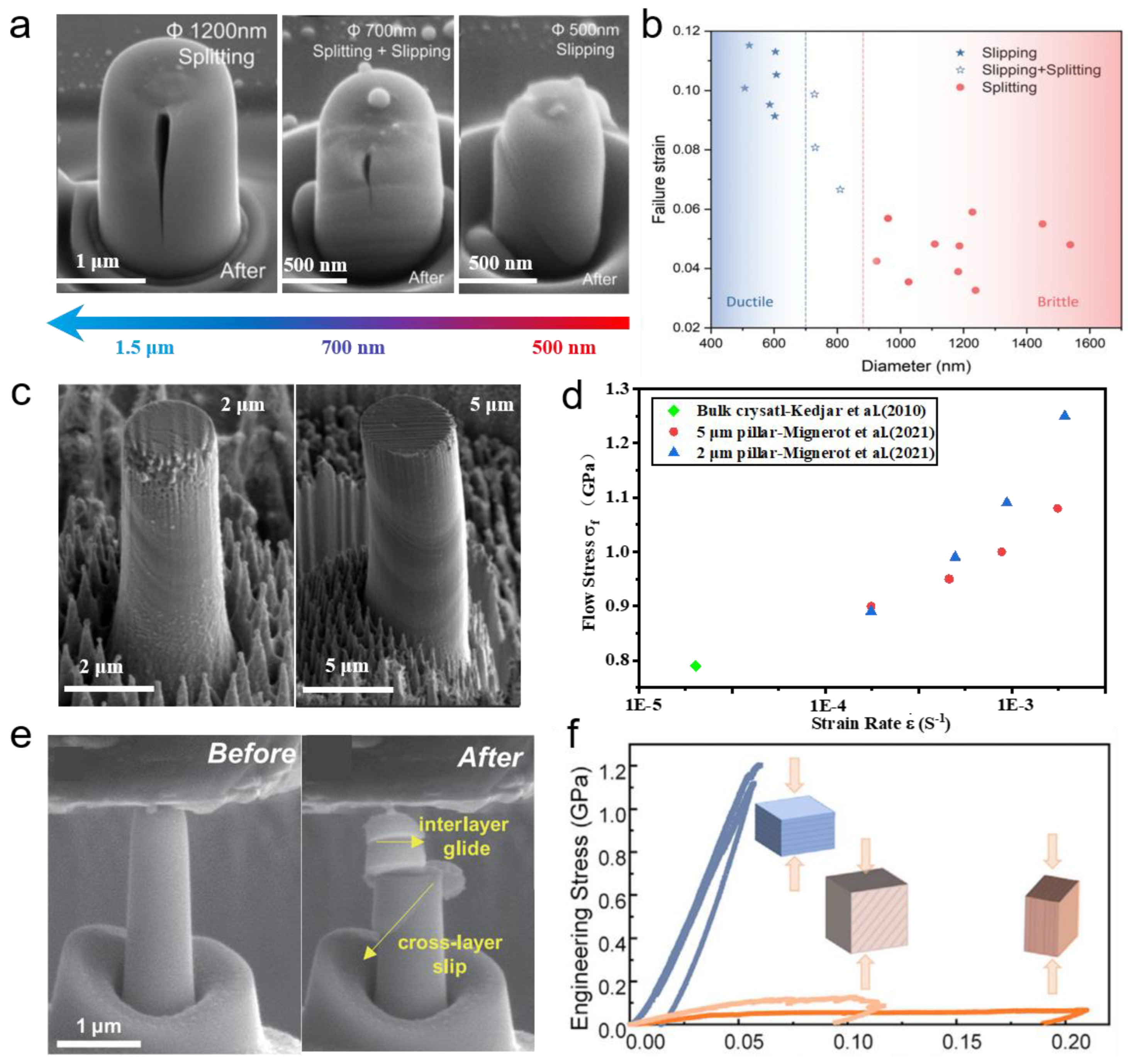
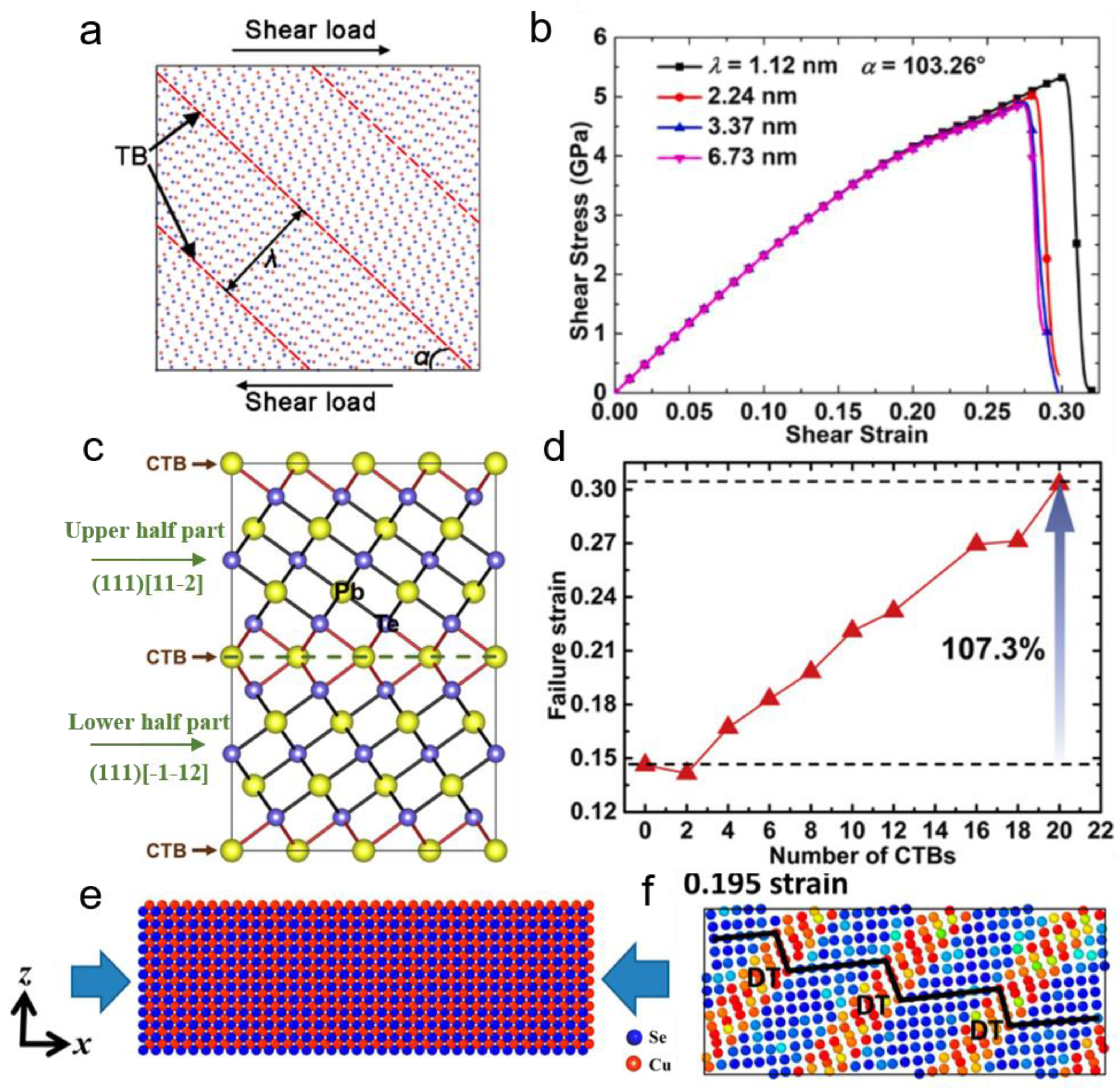

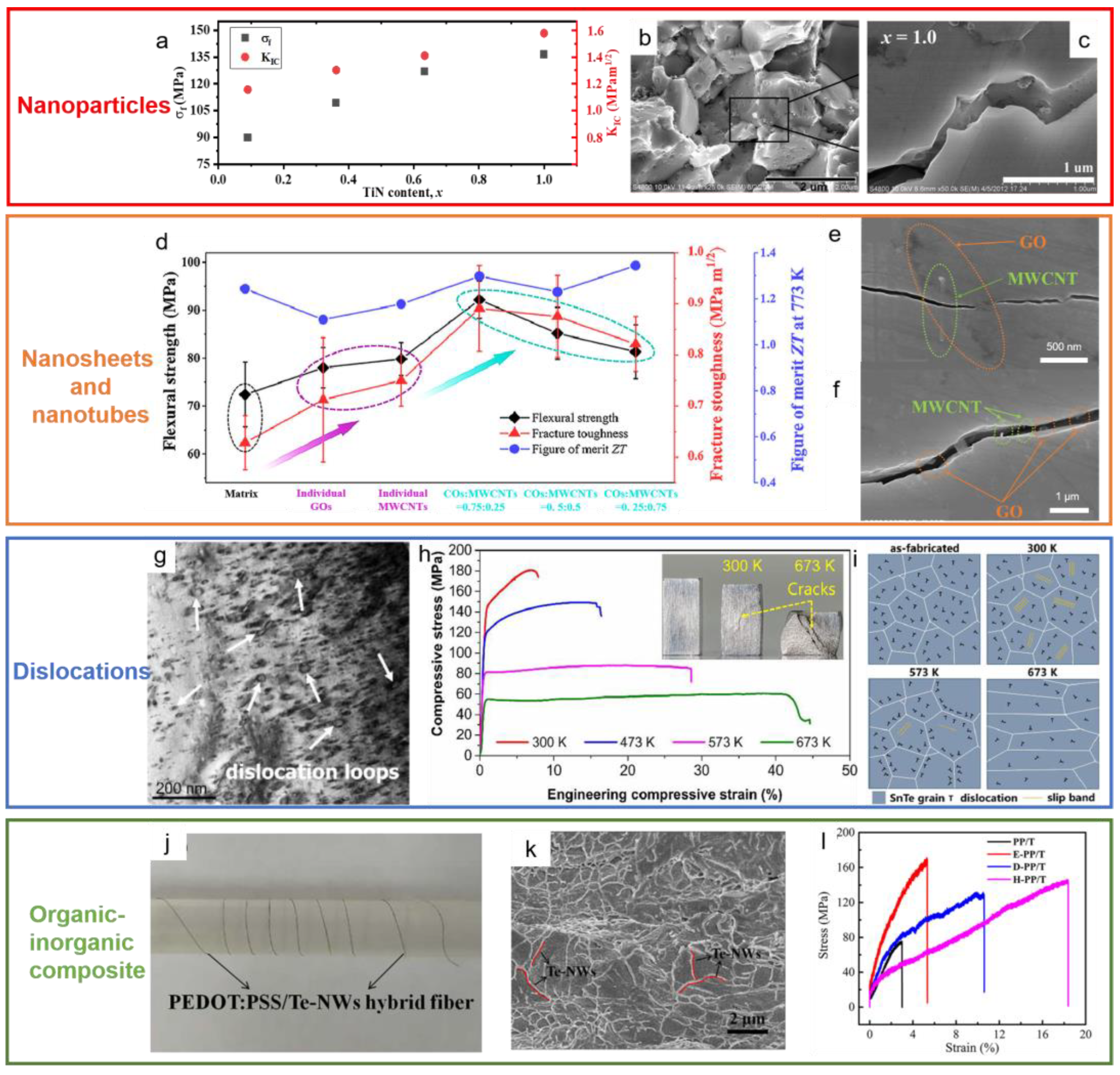
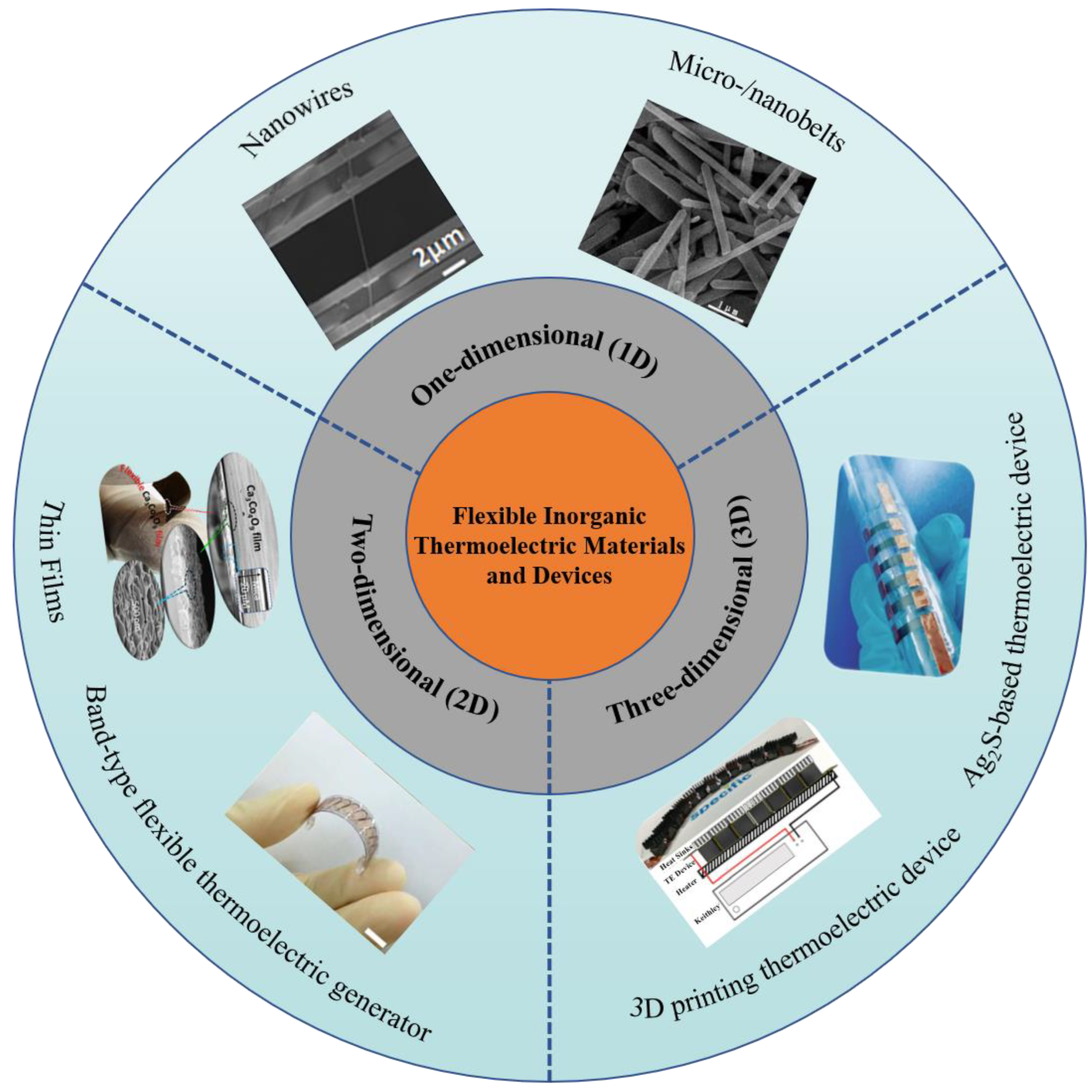
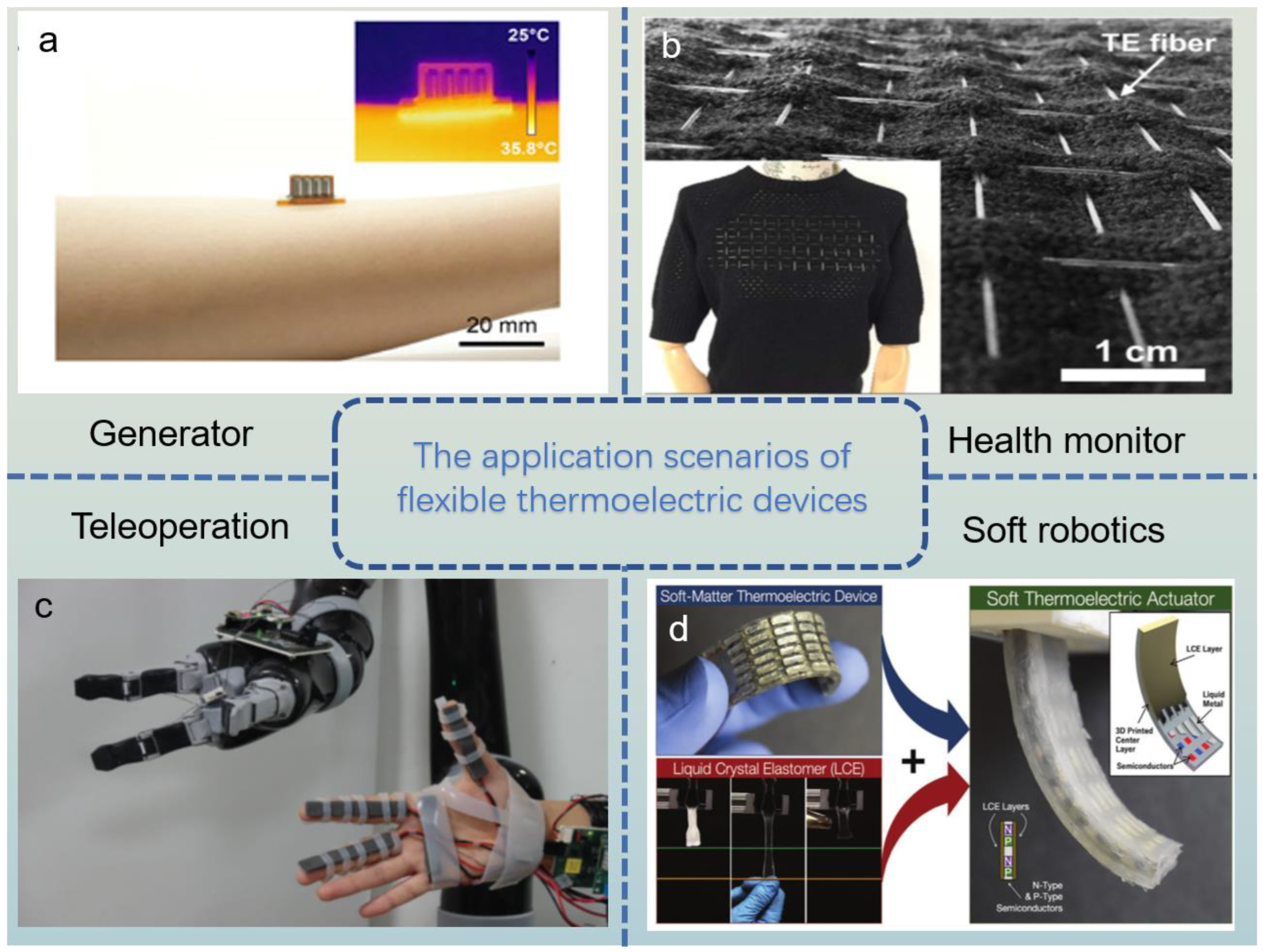
Disclaimer/Publisher’s Note: The statements, opinions and data contained in all publications are solely those of the individual author(s) and contributor(s) and not of MDPI and/or the editor(s). MDPI and/or the editor(s) disclaim responsibility for any injury to people or property resulting from any ideas, methods, instructions or products referred to in the content. |
© 2023 by the authors. Licensee MDPI, Basel, Switzerland. This article is an open access article distributed under the terms and conditions of the Creative Commons Attribution (CC BY) license (https://creativecommons.org/licenses/by/4.0/).
Share and Cite
Wu, L.; Feng, X.; Cao, K.; Li, G. Toughening Thermoelectric Materials: From Mechanisms to Applications. Int. J. Mol. Sci. 2023, 24, 6325. https://doi.org/10.3390/ijms24076325
Wu L, Feng X, Cao K, Li G. Toughening Thermoelectric Materials: From Mechanisms to Applications. International Journal of Molecular Sciences. 2023; 24(7):6325. https://doi.org/10.3390/ijms24076325
Chicago/Turabian StyleWu, Luoqi, Xiaobin Feng, Ke Cao, and Guodong Li. 2023. "Toughening Thermoelectric Materials: From Mechanisms to Applications" International Journal of Molecular Sciences 24, no. 7: 6325. https://doi.org/10.3390/ijms24076325
APA StyleWu, L., Feng, X., Cao, K., & Li, G. (2023). Toughening Thermoelectric Materials: From Mechanisms to Applications. International Journal of Molecular Sciences, 24(7), 6325. https://doi.org/10.3390/ijms24076325









